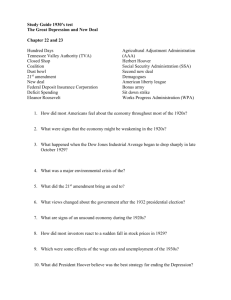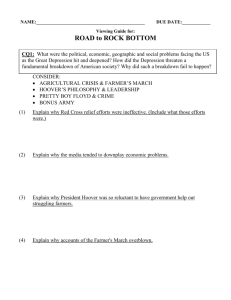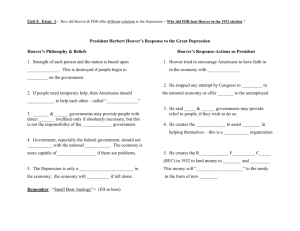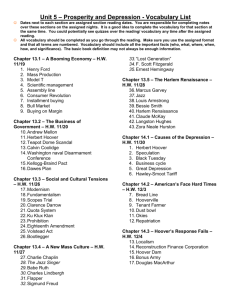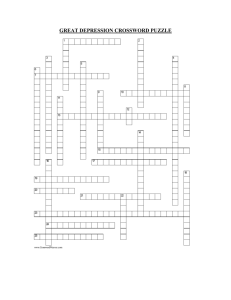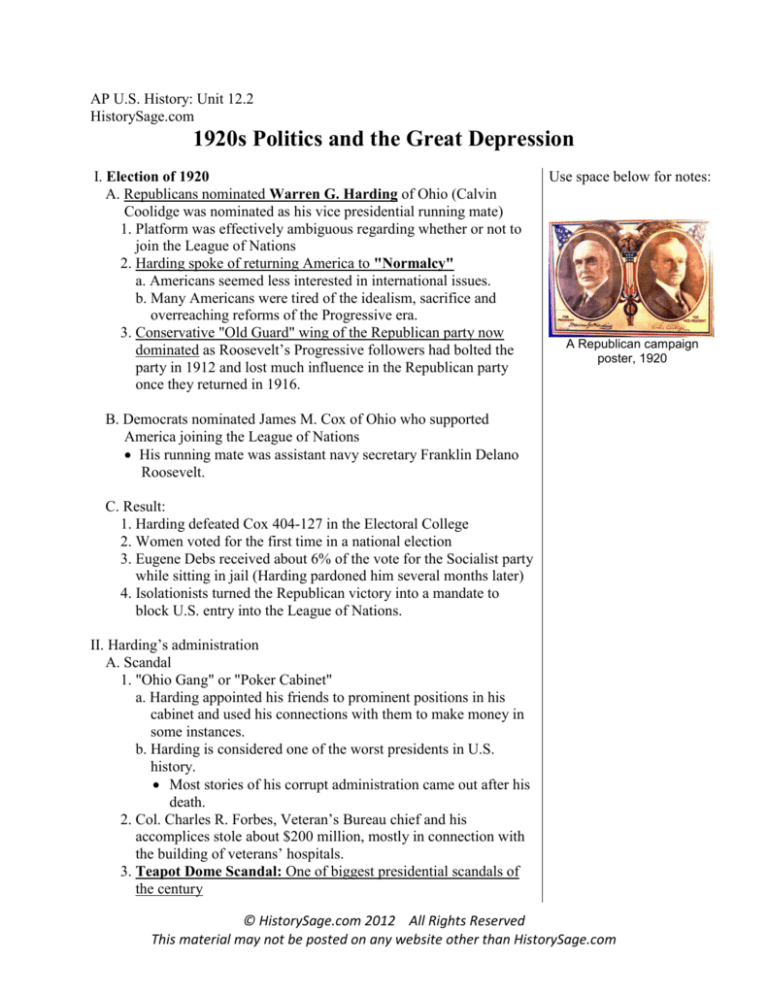
AP U.S. History: Unit 12.2
HistorySage.com
1920s Politics and the Great Depression
I. Election of 1920
A. Republicans nominated Warren G. Harding of Ohio (Calvin
Coolidge was nominated as his vice presidential running mate)
1. Platform was effectively ambiguous regarding whether or not to
join the League of Nations
2. Harding spoke of returning America to "Normalcy"
a. Americans seemed less interested in international issues.
b. Many Americans were tired of the idealism, sacrifice and
overreaching reforms of the Progressive era.
3. Conservative "Old Guard" wing of the Republican party now
dominated as Roosevelt’s Progressive followers had bolted the
party in 1912 and lost much influence in the Republican party
once they returned in 1916.
Use space below for notes:
A Republican campaign
poster, 1920
B. Democrats nominated James M. Cox of Ohio who supported
America joining the League of Nations
His running mate was assistant navy secretary Franklin Delano
Roosevelt.
C. Result:
1. Harding defeated Cox 404-127 in the Electoral College
2. Women voted for the first time in a national election
3. Eugene Debs received about 6% of the vote for the Socialist party
while sitting in jail (Harding pardoned him several months later)
4. Isolationists turned the Republican victory into a mandate to
block U.S. entry into the League of Nations.
II. Harding’s administration
A. Scandal
1. "Ohio Gang" or "Poker Cabinet"
a. Harding appointed his friends to prominent positions in his
cabinet and used his connections with them to make money in
some instances.
b. Harding is considered one of the worst presidents in U.S.
history.
Most stories of his corrupt administration came out after his
death.
2. Col. Charles R. Forbes, Veteran’s Bureau chief and his
accomplices stole about $200 million, mostly in connection with
the building of veterans’ hospitals.
3. Teapot Dome Scandal: One of biggest presidential scandals of
the century
© HistorySage.com 2012 All Rights Reserved
This material may not be posted on any website other than HistorySage.com
HistorySage.com APUSH Lecture Notes
Unit 12.2: 1920s- Politics and Depression
a. 1921, Secretary of the Interior Albert Fall arranged transfer of
valuable naval oil reserves at Teapot Dome, Wyoming & Elk
Hills, California to the Interior Department.
b. Harding signed the secret order.
c. Fall then leased lands to two oilmen and received a bribe of
about $400,000
d. The scandal became public in 1923 and the three men were
indicted in 1924 but the case was not resolved until 1929.
Fall was sentenced to one year in jail.
The two oilmen were acquitted of the bribe
Scandal undermined Americans’ faith in the courts & public
officials
4. Attorney General Harry Daugherty was investigated by the U.S.
Senate for illegal sale of pardons and liquor permits.
a. He was forced to resign and brought to trial in 1927.
b. The jury twice failed to convict him.
c. One of his advisors committed suicide in the face of the
scandal.
B. Harding died in San Francisco in Aug. 1923, while on a speech tour
1. Scandals had not yet reached the public in full force.
2. Stress from the scandals may have prompted his death.
3. Vice president Calvin Coolidge assumed the presidency.
C. Significant members of Harding’s cabinet
1. Charles Evans Hughes: Secretary of State
Led several important international peace conferences
2. Andrew W. Mellon: Secretary of the Treasury
a. Lowered the national debt and taxes for the wealthy
b. Pittsburgh aluminum king, major financier; perhaps the richest
man in the U.S.
3. Herbert Hoover: Secretary of Commerce
a. Only major progressive cabinet member; sought reforms
b. Promoted increased cooperation between government and
business
c. Made headlines in 1927 for his humanitarian role in dealing
with the Great Mississippi Flood.
His broken promises to African Americans in the region,
however, later cost him politically in the 1932 election
4. The Republican "Old Guard" dominated Harding’s administration
His administration resembled the McKinley-style old order of
the Gilded Age
© HistorySage.com 2012 All Rights Reserved
Page 2
Use space below for notes:
HistorySage.com APUSH Lecture Notes
Unit 12.2: 1920s- Politics and Depression
D. Harding’s conservative economic agenda (carried out by Coolidge
and Hoover)
1. Conservatives believed role of gov’t was to make business more
profitable.
a. Tax cuts for corporations and the wealthy: "trickle down"
economics
Advocated by Sec. of the Treasury Andrew Mellon who
favored rapid expansion of capital investment.
Premise: high taxes forced investors to invest in tax-exempt
securities rather than in factories that provided economic
growth.
o In practice, it resulted in a smaller net return to the
Treasury than moderate taxes.
Tax cuts for the wealthy, he believed, would result in
investment in business which would expand the economy
and create more jobs for ordinary workers.
Mellon thus engineered a series of tax cuts from 1921 to
1926
Much of tax burden was shifted to the middle-class
b. Higher tariffs: Fordney-McCumber Tariff (1922)
Businessmen feared cheap goods coming in from Europe.
Tariff rates pushed from 27% (under the Underwood Tariff)
to about 38.5% (almost as high as the Payne-Aldrich Tariff
of 1909).
Duties on farm produce were increased
Impact:
o Europeans’ post-WWI economic recovery was hurt
o Europeans had more trouble paying huge debt owed to
the U.S.
o Retaliatory tariffs against U.S. goods hurt U.S.
manufacturers.
High European tariffs also hurt neighboring
Europeans.
2. Government’s role should be limited and stay out of the way of
business (laissez faire)
a. Less government regulation occurred than in the Progressive
era, and few regulatory laws were passed
b. Harding appointed people to regulate agencies that didn't like
progressive regulation
Interstate Commerce Commission was dominated by men
personally sympathetic to the managers of the railroads.
3. Government helped to facilitate monopolies and consolidation of
industries
a. Antitrust laws often ignored, circumvented, or inadequately
enforced by Attorney General Daugherty
© HistorySage.com 2012 All Rights Reserved
Page 3
HistorySage.com APUSH Lecture Notes
Unit 12.2: 1920s- Politics and Depression
b. Industrialists set up trade associations where an industry
would agree upon standardization of a product, publicity
campaigns, and a united front in dealing with other industries
and customers.
Despite violating antitrust legislation, Secretary of
Commerce Herbert Hoover encouraged their formation.
Trade associations sought to eliminate cutthroat
competition.
4. Businessmen ran the government as they were seen to have had
experience in management.
Cabinet positions went to wealthy business leaders who looked
out for big business interests.
5. Rejected federal gov’t programs to help ordinary citizens or local
economies
a. To the Mississippi flood victims appeal: "The gov’t is not an
insurer of its citizens against the hazards of the element."
b. A plan to develop government-controlled hydroelectric power
stations near Muscle Shoals in the Tennessee Valley was
rejected by presidents Harding and Coolidge as too socialistic.
Such a project would have significantly improved the
economy of the Tennessee Valley region, one of the
nation’s poorest areas.
Muscle Shoals eventually became the nucleus of the
Tennessee Valley Authority during the New Deal in the
1930s.
c. Many conservatives believed local communities and charity
should take that responsibility
This was largely Hoover’s philosophy during the
Depression
6. Conservatives were appointed to the Supreme Court.
a. Harding appointed 4 Supreme Court justices in his less than 3
years as president
Judges were often reactionary and held back reforms for
nearly two decades.
Exception: Harding appointed former president William H.
Taft as Chief Justice, who was relatively liberal
b. The Court reversed many of labor’s gains, and restricted
government intervention in the economy.
Adkins v. Children’s Hospital (1923): the Court invalidated
a minimum-wage law for women.
o Justification: Females now had the vote and no longer
could be protected by special legislation.
7. Conservatives were hostile to Unions
a. Conservatives were shocked by the 1919 Seattle General
Strike, Boston Police Strike, steel strike, United Mine Workers
© HistorySage.com 2012 All Rights Reserved
Page 4
HistorySage.com APUSH Lecture Notes
Unit 12.2: 1920s- Politics and Depression
strike, and others
b. Membership in labor unions dropped nearly 30% between 1920
and 1930; dropped from approximately 12% of the civilian
labor force to 8%.
c. 1922, the Railway Labor Board ordered 12% wage cut sparking
a two-month railroad strike
Attorney General Daugherty implemented one of the most
sweeping injunctions in U.S. history.
8. Reduced the national debt by making government smaller
a. Nat’l debt increased from $1.2 billion in 1914 to about $24
billion in 1921.
b. Bureau of the Budget was created by Congress in 1921 to
reduce the national debt.
c. Treasury Secretary Andrew Mellon reduced the national debt
from about $26 billion to $16 billion.
III. Calvin Coolidge’s presidency (1923-1929)
A. Coolidge carried out Harding’s conservative agenda
B. The Farm Problem
1. Causes
a. Recovery of European farmers brought less demand for U.S.
farm products.
b. Machines facilitated more food production but the increased
supply meant a decrease in food prices.
The gasoline-powered tractor revolutionized American
farms.
2. A depression hit the agricultural sector in the 1920s as 25% of
farms were sold for debt or taxes.
a. Foreclosures increased 500% between 1918 and 1923
b. Foreshadowed the Great Depression later in the decade
3. McNary-Haugen Bill (proposed repeatedly between 1924 to
1928)
a. Bipartisan Congressional "farm bloc" from agricultural states
aimed to help farmers.
b. Sought to keep agricultural prices high by authorizing the gov’t
to buy up surpluses and sell them abroad.
c. Gov’t losses would be made up by a special tax on the farmers.
d. Coolidge vetoed it twice
e. Result: Farm prices stayed down
C. Election of 1924
1. Party nominations
a. Republicans nominated incumbent Calvin Coolidge
b. Democrats nominated conservative businessman John W.
Davis
© HistorySage.com 2012 All Rights Reserved
Page 5
HistorySage.com APUSH Lecture Notes
Unit 12.2: 1920s- Politics and Depression
The party was divided among various factions: "wets" vs.
"drys"; fundamentalists vs. modernists; northern liberals vs.
southern white supremacists; immigrants vs. WASPs
A resolution to condemn the KKK failed by one vote.
c. The new Progressive party nominated Senator Robert
"Fighting Bob" La Follette.
Endorsed by the AFL and the shrinking Socialist party.
Bulk of support came from farmers
Platform:
o Gov’t ownership of railroads and relief for farmers
o Anti-monopoly and anti-labor injunctions
o Constitutional amendment to limit Supreme Court’s
power to invalidate laws passed by Congress (in effect,
an attack on judicial review).
2. Result:
a. Coolidge defeated Davis & La Follette 382 - 136 - 13 in the
Electoral College
b. La Follette received nearly 5 million votes (all electoral votes
came from his home state of Wisconsin).
c. The nation’s current prosperity meant that the incumbent party
was not going to be defeated; reform was not high on the list
of most Americans at this time.
Memory Aid for Conservative Politics in the 1920s: “HALT”
H igher tariffs
A nti-Union
L aissez faire
T rickle-down tax policies
IV. Election of 1928
A. Nominations
1. Herbert Hoover was the Republican nominee: platform of
prosperity & prohibition.
2. Alfred E. Smith was nominated by the Democrats
First Irish-American Catholic nominated by a major party
Smith had been a Tammany Hall boss, and was the "Wet" son
of Irish immigrants
Rural America and the South were deeply opposed to him.
B. Campaign
1. Radio was used significantly for the first time.
2. Hoover warned of "socialism" and preached "rugged
individualism"
3. Religious bigotry surfaced regarding Smith’s Catholicism: "A
© HistorySage.com 2012 All Rights Reserved
Page 6
HistorySage.com APUSH Lecture Notes
Unit 12.2: 1920s- Politics and Depression
vote for Al Smith is a Vote for the Pope."
C. Results:
1. Hoover defeated Smith 444 to 87 in the Electoral College
Hoover was the first Republican in 52 years to carry several
former Confederate states (he won 5).
2. A huge Republican majority was returned to the House of
Representatives.
The Republican victory in several former-Confederate states demonstrates the
high degree of anti-Catholicism that existed in the South against the Democrat
Al Smith
V. Hoover’s presidency (1929-1933)
A. Herbert Hoover
1. Organized food drives for the starving people of Belgium during
WWI.
2. His leadership of the Food Administration during WWI earned
him the titles of "Great Engineer" and "Wonder Boy."
3. Successful businessman who hated socialism or large-scale
gov’t intervention in the economy (not laissez faire, however)
4. As secretary of commerce, he supported some progressive ideas
e.g. endorsing labor unions and supporting federal regulation of
new radio broadcasting industry.
For a time, considered gov’t-owned radio like Britain’s BBC.
5. Claimed in 1928 that "Poverty will be banished from the nation."
"Everybody ought to be rich."
B. The Great Crash of 1929
1. Bull market: values of stocks continued to increase during the
1920s.
a. Dow Jones in 1924 = 180
© HistorySage.com 2012 All Rights Reserved
Page 7
HistorySage.com APUSH Lecture Notes
Unit 12.2: 1920s- Politics and Depression
b. September 1929 = 381: stocks were selling for 16 times their
earnings; rule of thumb = 10 times earnings
2. On margin buying of stocks
a. Investors purchased stocks from stockbrokers for as little as 5%
down
b. When stock values rose, investors would pay back their debt.
If no payment was made, stocks would be held as collateral.
c. If prices of stock decreased more than 10%, the broker would
sell stock for whatever price they could get.
Result: Banks and businesses that had financed brokers’
loans lost much money.
d. Banks loaned money to stockbrokers to facilitate on margin
buying.
3. Overspeculation:
a. Investors gambled that prices would continue to rise
b. Artificial increases in stock and commodity values fueled
speculation
c. Hoover unsuccessfully tried early on to curb speculation
by pressuring the Federal Reserve Board to raise the Federal
discount rate (the rate the Fed charges to member banks).
4. The Great Crash
a. Oct. 29, 1929 ("Black Tuesday") -- Everybody wanted to sell.
Within hours, the stock market crashed.
b. By mid-November, $25 billion in stock value had disappeared
Fortunes were wiped out almost overnight; Dow Jones in
1932 = 41; down from 381 in September, 1929.
5. Traditional historical interpretation puts the Crash as the
immediate cause of the Great Depression.
a. However, no direct connection has ever been proven
In fact, there are few universally-agreed upon causes for
the depression
b. The recession actually began in August, 1929, two months
before the Crash.
-- This was largely due to contractionary policies by the
Federal Reserve Board that sought to curb overspeculation
on stocks
c. U.S. did not sink into a major depression until December 1930
after several major banks collapsed (e.g. Bank of U.S., a NY
private bank)
d. Some economists put the cause of the international depression
as late as 1931 when certain major European banks collapsed
(e.g. Kreditanstaldt in Austria)
e. After “Black Tuesday,” stock prices were still at 1926 levels,
which were strong.
f. The stock market regained much of its losses by mid-1930
g. Other factors may have been more important (see below)
© HistorySage.com 2012 All Rights Reserved
Page 8
HistorySage.com APUSH Lecture Notes
Unit 12.2: 1920s- Politics and Depression
VI. Long-term Causes of the Great Depression
A. Weak industries
1. Cotton industry was affected by the rise of synthetic materials.
2. Railroad industry was affected by the automobile and airplane.
Railroad passenger miles declined from 47 million in 1922 to
34 million in 1927
3. Coal industry declined in the face of the electrical, oil, and
chemical industries
4. Low food prices affected the farming industry (see pages 5 & 6)
a. Demand for foodstuffs dropped after WWI.
b. Government refused price supports in 1920's.
B. Overproduction of goods by manufacturers
1. Consumers began to spend less on goods -- underconsumption
a. Ordinary workers and farmers had used their consumer credit
and did not have enough money to keep buying products that
were produced.
b. Immigration laws of the 1920s reduced population growth
that, in turn, reduced aggregate demand
2. Many warehouses were full of products that couldn't be sold.
Companies lost money.
C. Uneven distribution of income
1. 5% of the population received 30% of the total income.
a. One estimate: Income of top 1% increased about 75%; bottom
93% = only 6%.
b. Partly due to Andrew Mellon’s “trickle down” policies
c. Urban industrial workers tended to earn more than farmers
2. One-half of country lived below the poverty line. These were
potential customers.
D. Unstable banking system
1. Due to mismanagement in real estate and overspeculation in the
stock market
2. 1% of banks controlled 46% of bank resources.
3. Runs on banks caused many banks to close after the Crash
E. Weak international economy
1. U.S. protectionist trade policies hurt foreign trade
a. Fordney-McCumber Tariff, 1922 (see pages 3 & 4)
b. Hawley-Smoot Tariff (1930) --created highest tariff in U.S.
history
23 nations retaliated by imposing tariffs on U.S. exports.
2. The U.S. economy in 1929 was less affected by the weak
international economy due to foreign trade representing a small
percentage of the overall U.S. economy
© HistorySage.com 2012 All Rights Reserved
Page 9
HistorySage.com APUSH Lecture Notes
Unit 12.2: 1920s- Politics and Depression
Yet, loan defaults from foreign countries and reduced demand
ultimately worsened the crisis in the U.S.
VII. The Great Depression
A. By 1932, 5,761 banks had failed (22% of the total)
1. Many banks invested in stocks before the crash
2. 4,000 more banks collapsed between December 1932 and the
new president’s inauguration in March, 1933
B. Thousands of businesses failed
1. 20,000 in 1929; 30,000 in 1932
2. Business investment between 1929 and 1932 decreased by
nearly 95%!
C. Unemployment reached 25% by 1932 (13 million people) excluding
farmers.
a. As high as 33% including farmers; Chicago = 50%!
b. Low-skilled workers most affected (professionals & middle-class
suffered less)
Blacks and immigrant workers especially hard hit (lowskilled)
c. Unemployment had been as low as 3.2% in 1929
d. Auto industry only functioned at 20% of capacity by 1932; steel
industry only 12% of capacity
D. Total wages dropped from $12 billion to $7 billion from 1929 to
1932 (lower wages = less money spent in the economy); about 41%
1. Partly due to deflation
2. Increase in child labor occurred as a result
E. By 1932, 25% of farmers had lost their farms
A major cause was the large drop in food prices caused by
overproduction and less demand from Europe
F. Human Cost
1. Many people experienced a loss of self-worth
2. Many families broke up; the marriage rate and birth rate declined
Families doubled up in houses and apartments
3. Three million people became hobos and lived in makeshift shacks
known as "Hoovervilles"
4. Malnutrition was rampant in certain areas but death by starvation
was uncommon.
Nevertheless, malnutrition caused people to be more
susceptible to fatal diseases.
© HistorySage.com 2012 All Rights Reserved
Page 10
HistorySage.com APUSH Lecture Notes
Unit 12.2: 1920s- Politics and Depression
G. The Depression was the longest and most devastating in U.S.
history
1. The U.S. was hit the hardest among industrialized nations.
Gross National Product fell from $104 billion in 1929 to $56.1
billion in 1933.
2. The international reparations and war debts structure collapsed.
3. U.S. exports dropped, further hurting the U.S. economy.
4. Not until the U.S. began preparing for World War II in 1939 did
the depression end (by then it had lasted 10 years).
VIII. Hoover’s response to the Great Depression
A. Hoover did not respond quickly enough
1. Hoover believed (perhaps correctly) that outside forces in Europe
were responsible for the Great Depression.
a. Economic consequences of WWI (especially the Versailles
Treaty and German reparations)
b. Post-war military alliances and doubling of prewar armament.
c. Inflationary public works programs to alleviate unemployment.
d. Unbalanced budgets and increasing debt.
2. Hoover thus took too long to initiate domestic measures to help
the economy believing instead the international system had to be
repaired first.
B. Farming
1. Pre-crash: Agricultural Marketing Act passed by Congress in
1929.
a. Designed to help farmers help themselves, largely through
producers’ cooperatives.
b. Indicated Hoover’s progressive tendencies; Coolidge had
vetoed such policies
2. Federal Farm Board established in 1930 with a revolving fund
of $500 million
a. Lent funds to buy, sell and store agricultural surpluses.
b. Goal: raise sagging prices by buying up surpluses and selling
them abroad
The policy failed as the production of food increased further
C. Attempts at economic recovery
1. Volunteerism
a. Hoover believed voluntary cooperation (like in WWI) would
enable the country to overcome the depression.
b. He urged businesses to avoid lay-offs of workers and wage cuts
Eventually, the worsening economy forced businesses to cut
workers and wages anyway
c. He secured no-strike pledges from labor leaders.
d. He urged all citizens to contribute to charities to ease the
© HistorySage.com 2012 All Rights Reserved
Page 11
HistorySage.com APUSH Lecture Notes
Unit 12.2: 1920s- Politics and Depression
suffering; Hoover himself donated generously
In reality, private charity was not adequate to meet the
country’s needs during the economic calamity.
2. Hawley-Smoot Tariff of 1930
a. Tariff became the highest peace-time barrier in the nation’s
history.
The average duty increased from 38.5% (FordneyMcCumber Tariff of 1922) to nearly 60%.
b. It exacerbated the existing international economic depression.
Foreign countries interpreted the tariff as an economic
declaration of war as the volume of trade shrunk
c. International financial chaos resulted in the U.S. becoming
even more isolationist
3. Public works
a. In 1930 Congress appropriated $750 million for public
buildings, river and harbor improvements, and highway
construction to stimulate employment.
b. Hoover Dam construction began in 1931 and was completed in
1936.
Construction of the dam employed thousands and created
huge man-made lake for purposes of irrigation, flood
control, and electric power.
c. By 1932, the efforts of the president and Congress had yielded
little in economic growth
4. Moratorium on international debts (1931)
a. Hoover courageously pushed for a 1-year freeze on
international debt payments to help European countries
(especially Germany) recover.
b. Yet, the international economy was too heavily damaged for
this to make much difference.
5. Reconstruction Finance Corporation (RFC), 1932
a. RFC had an appropriation of $500 million and the authority to
borrow $1.5 billion for loans to railroads, banks, and other
financial institutions.
b. Later, Hoover approved legislation authorizing RFC to lend
$300 million to states for relief, and to make loans to states and
cities for self-liquidating public works.
Became a “mini-blue print” for the New Deal in the 1930s
during Franklin Roosevelt’s presidency
c. Result: prevented the failure of basic firms on which many
other elements of the economy depended, but was criticized by
some as relief for the rich.
6. Norris-La Guardia Anti-Injunction Act (1932): Outlawed
"yellow dog" (antiunion) contracts and forbade the
federal courts to issue injunctions to restrain strikes, boycotts,
and peaceful picketing.
© HistorySage.com 2012 All Rights Reserved
Page 12
HistorySage.com APUSH Lecture Notes
Unit 12.2: 1920s- Politics and Depression
7. Revenue Act of 1932 further reduced demand through taxation
on personal income and mandating a balanced budget
D. Bonus Army, 1932
1. 14,000 unemployed veterans marched on Washington in
the summer of 1932 to lobby Congress for payment of bonus
that was payable in 1945.
2. At Hoover’s insistence, the Senate did not pass the bonus bill and
about half of the Bonus Army accepted congressional
transportation back home.
3. The remaining 5,000 marchers lived in shanties along the
Anacostia river and continued to lobby for their cause.
4. Hoover called in the Army to remove the Bonus Army after two
veterans were killed in a clash with the police.
Veterans were driven from Washington, D.C. and their camps
were burned.
5. Significance: Hoover appeared heartless to already angry
Americans; contributed to his defeat in the November election.
E. Hoover evaluated
1. Despite not doing enough, Hoover advocated more direct gov’t
involvement than any previous president in the nation’s history.
a. Probably prevented a more serious collapse than did occur.
b. Policies paved the way for the New Deal (e.g. RFC)
c. Yet, his conservative underpinnings prevented him from going
far enough in addressing the worst slump in U.S. history.
2. His focus on maintaining a balanced budget through tax receipts
from the Revenue Act of 1932 further decreased demand
3. By refusing to get off the gold standard, the money supply in
the U.S. remained stagnant
In contrast, President Franklin Roosevelt took the nation off
the gold standard early in his presidency and the increased
money supply helped stimulate the economy, somewhat.
4. Refusal of large-scale relief resulted in misery among the masses
a. Hoover vetoed use of federal funds for relief for the needy.
He feared gov’t handouts were socialistic and would destroy
the nation’s work-ethic; he believed instead in “rugged
individualism.”
b. Hoover eventually compromised by authorizing the RFC to
lend millions to states for relief but this proved to be too little,
too late.
© HistorySage.com 2012 All Rights Reserved
Page 13
HistorySage.com APUSH Lecture Notes
Unit 12.2: 1920s- Politics and Depression
Page 14
Terms to Know
election of 1920
isolationism
President Warren G. Harding
“normalcy”
Teapot Dome Scandal
Andrew Mellon, Treasury Secretary
Herbert Hoover, Commerce Secretary
“trickle-down” economics
Fordney-McCumber Tariff
trade associations
Bureau of the Budget
McNary-Haugen Bill
Isolationism
Election of 1928
Al Smith
President Herbert Hoover
bull market
bear market
on margin buying of stocks
overspeculation
Great Crash of 1929 (“Black Tuesday”)
overproduction
underconsumption
runs on banks
Hawley-Smoot Tariff, 1930
Great Depression
deflation
“Hoovervilles”
Agricultural Marketing Act, 1929
Federal Farm Board
debt moratorium
Reconstruction Finance Corporation
Norris-LaGuardia Anti-Injunction Act
Bonus Army
Essay Questions
Note: This sub-unit is a high probability area for the AP exam. In the past
10 years, 3 questions have come wholly or in part from the material in this
chapter. Below are some questions that will help you study the topics that
have appeared on previous exams.
1. Compare and contrast the conservative policies of the 1920s presidents with the
progressive policies prior to 1920.
2. Analyze the long-term and short-term causes of the Great Depression.
3. To what extent was Herbert Hoover a failure in his response to the problems of
the Great Depression?
© HistorySage.com 2012 All Rights Reserved
HistorySage.com APUSH Lecture Notes
Unit 12.2: 1920s- Politics and Depression
Bibliography:
College Board, Advanced Placement Course Description: United States
History, College Entrance Examination Board, published annually
Foner, Eric & Garraty, John A. editors: The Reader’s Companion to
American History, Boston: Houghton Mifflin Company, 1991
John Kenneth Galbraith, The Great Crash: 1929, Boston: Houghton
Mifflin (1972)
Hofstadter, Richard, The Age of Reform, New York: Random House,
1955
________________, The American Political Tradition, New York:
Alfred Knopf, 1948
Kennedy, David M., Cohen, Lizabeth, Bailey, Thomas A., The American
Pageant, 14th edition, Florence, Kentucky: Cengage Learning 2010
Kennedy, David M., Freedom From Fear: The American People in
Depression and, War, 1929-1945, New York: Oxford University
Press, 1999
Nash, Gary, American Odyssey, Lake Forest, Illinois: Glencoe, 1992
© HistorySage.com 2012 All Rights Reserved
Page 15



